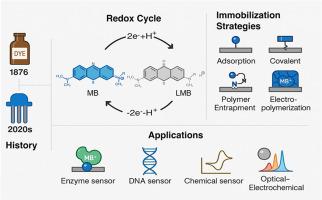亚甲基蓝在电化学(生物)传感中的应用:历史演变、机制见解和新兴应用综述
IF 6
2区 化学
Q1 CHEMISTRY, ANALYTICAL
引用次数: 0
摘要
亚甲基蓝(MB)是一种具有氧化还原活性的吩噻嗪染料,已经从历史上的纺织品着色剂转变为现代电化学生物传感的核心成分。其可逆的氧化还原特性、明显的颜色变化以及与生物氧化还原体系的相容性使其成为理想的介质和指示剂。然而,介质浸出、膜降解和复杂基质中的干扰等挑战阻碍了其更广泛的应用。本文通过分析MB的电化学特性、固定策略和传感器集成技术来解决这些局限性。结果通过伏安法和光谱电化学分析,发现smb与自由基中间体之间存在质子耦合的两步电子转移过程。四种固定策略-吸附,共价结合,聚合物包埋和电聚合-在稳定性和信号再现性方面影响传感器的性能。应用范围包括基于酶的葡萄糖和H2O2生物传感器(纳摩尔检测),使用杂交和dna介导的电荷传输的核酸传感器,以及电催化化学传感(例如Cr(VI), NADH)。与纳米材料的集成提高了表面积和灵敏度。防污涂层和比例检测提高了选择性和使用寿命,证明了MB与先进材料和制造平台的兼容性。MB与新兴纳米材料和固定化技术的结合增强了其在下一代电化学生物传感器中的作用。它的双重光学电化学功能和介质的多功能性使设计敏感,稳定和小型化的即时诊断成为可能。本文章由计算机程序翻译,如有差异,请以英文原文为准。

Methylene Blue in Electrochemical (Bio)sensing: Historical Evolution, Mechanistic Insights, and Emerging Applications—A Review
Background
Methylene blue (MB), a redox-active phenothiazine dye, has transitioned from a historical textile colorant to a central component in modern electrochemical biosensing. Its reversible redox behavior, distinct color change, and compatibility with biological redox systems make it an ideal mediator and indicator. However, challenges such as mediator leaching, film degradation, and interference in complex matrices hinder broader application. This review addresses these limitations by analyzing MB's electrochemical properties, immobilization strategies, and sensor integration techniques.Results
MB exhibits a proton-coupled, two-step electron transfer process with radical intermediates, revealed by voltammetry and spectroelectrochemistry. Four immobilization strategies—adsorption, covalent binding, polymer entrapment, and electropolymerization—impact sensor performance in terms of stability and signal reproducibility. Applications span enzyme-based glucose and H2O2 biosensors (nanomolar detection), nucleic acid sensors using hybridization and DNA-mediated charge transport, and electrocatalytic chemical sensing (e.g., Cr(VI), NADH). Integration with nanomaterials enhances surface area and sensitivity. Anti-fouling coatings and ratiometric detection improve selectivity and operational longevity, demonstrating MB's compatibility with advanced materials and fabrication platforms.Significance
The integration of MB with emerging nanomaterials and immobilization techniques reinforces its role in next-generation electrochemical biosensors. Its dual optical–electrochemical function and mediator versatility enable the design of sensitive, stable, and miniaturized point-of-care diagnostics.求助全文
通过发布文献求助,成功后即可免费获取论文全文。
去求助
来源期刊

Analytica Chimica Acta
化学-分析化学
CiteScore
10.40
自引率
6.50%
发文量
1081
审稿时长
38 days
期刊介绍:
Analytica Chimica Acta has an open access mirror journal Analytica Chimica Acta: X, sharing the same aims and scope, editorial team, submission system and rigorous peer review.
Analytica Chimica Acta provides a forum for the rapid publication of original research, and critical, comprehensive reviews dealing with all aspects of fundamental and applied modern analytical chemistry. The journal welcomes the submission of research papers which report studies concerning the development of new and significant analytical methodologies. In determining the suitability of submitted articles for publication, particular scrutiny will be placed on the degree of novelty and impact of the research and the extent to which it adds to the existing body of knowledge in analytical chemistry.
 求助内容:
求助内容: 应助结果提醒方式:
应助结果提醒方式:


